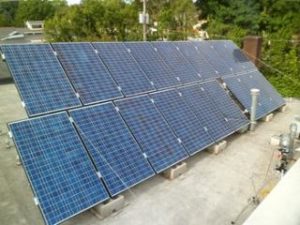Breaking New York’s community solar backlog
 Community solar allows people unable to put solar on their own homes the ability to receive the benefits of solar. Community solar can take on several forms. The basic idea is that community solar participants take a stake in an off-site solar project and are able to credit the electricity produced to their home. Community solar presents a great opportunity to expand the use of a distributed energy resource while expanding access to the benefits of solar.
Community solar allows people unable to put solar on their own homes the ability to receive the benefits of solar. Community solar can take on several forms. The basic idea is that community solar participants take a stake in an off-site solar project and are able to credit the electricity produced to their home. Community solar presents a great opportunity to expand the use of a distributed energy resource while expanding access to the benefits of solar.
But this opportunity is facing a hard reality in New York State, where a 2-gigawatt pipeline of community solar projects faces a massive backlog. It’s possible that much, if not most, of this project pipeline will never get built. New York has been an early adopter of policies that promote community solar. The difficulties the state has had in actually implementing projects should serve as a cautionary tale to other states that are moving toward community solar.
New York’s Public Service Commission passed an order last year enabling groups of ten people or more to join together to form a community solar project. These groups could generate electricity from, or subscribe to, off-site projects and have the electricity generated by the project count toward the group member’s electric bills.
This order led to a mad dash. “A lot of big companies have jumped in and have jammed up the interconnection queue,” said Susan Gillespie of Citizens for Local Power. Citizens for Local Power fights for community-focused energy policy in the mid-Hudson Valley. The volume of these requests has inundated utilities across the state.
What’s worse, Gillespie said, is that many developers are filing these requests even though they don’t yet have the land rights for the systems they are proposing to develop. She also expressed concerns about the fairness of the contracts and whether or not they were actually providing benefits to the land-owner and local community.
One source of this problem was the low bar for entry to join the interconnection queue. In May, more stringent guidelines were enacted. Previously, all developers had to do was pay a $350 fee to be added. This incentivized developers to get projects unlikely to ever be developed into the queue.
There are several reasons why a developer might decide doing so was worthwhile, according to Hannah Masterjohn of developer Clean Energy Collective. She noted developers have a hard time knowing how much it will cost them to connect their proposed project to the electric grid.
Entering the interconnection queue allows them to obtain this information from the relevant utility. This means developers who only have the capital to complete one project would submit multiple interconnection requests to see where they can get the best price. Along the same lines, developers may opt to enter several projects in the queue knowing not all of them will come to fruition as a way to hedge against projects that end up not getting built.
The New York Public Service Commission implemented tighter restrictions earlier this year for requirements to enter the interconnection queue. While this should alleviate some issues going forward, that still leaves the problem of the hundreds of megawatts worth of solar projects that are still stranded in the queue.
The commission created a working group made up of various stakeholders to work through this. Their goal is to determine a fair way to evaluate the queue. The process of clearing up the queue is just one step to improve community solar in New York.
“The market is looking for more regulatory certainty so that we can feel comfortable to invest in later stage development,” Masterjohn said. A primary concern, said Masterjohn is the valuation of the electricity produced from community solar projects. New York’s Public Service Commission is still in the process of determining this value.
Another issue Masterjohn cited was that of interconnection cost sharing. Solar developers have to pay for the cost of upgrading the transmission system around the substation where their project is built. Subsequent projects on the same substation grid would not have to pay for these upgrades. This creates a strong first-mover disadvantage. Masterjohn said policymakers need to develop a system by which these costs could be shared by multiple developers.
Recently, the working group filed a proposal to fix the issues with the interconnection queue. The proposal would require several steps for applications to stay in the queue.
The proposal sets up a timeline by which developers must meet certain benchmarks, or otherwise be removed from the interconnection queue. Additionally, developers must show they have consent of the property owner to complete a project on the owner’s land. The proposal also outlines a path by which projects could share the burden of interconnection upgrades.
These fixes are designed to alleviate stresses on the interconnection queue and enable viable projects to proceed.
